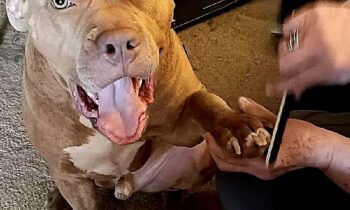
You’ve heard the term, you’ve seen it in ads, you’ve watched some videos. You know that “force-free” is being touted as the latest thing in dog training . . . but what does it really mean? Is force-free different from what you learned in dog obedience classes 20 years ago? Is force-free training better than the way dogs were trained before? Will you recognize force-free training when you see it?
Jean Donaldson, Director of The San Francisco/SPCA Academy for Dog Trainers and author of “The Culture Clash,” explains:
The big watershed in dog training is whether or not to include pain and fear as means of motivation. In the last twenty years the pendulum swing has been toward methods that use minimal pain, fear or intimidation—or none at all.
The force-free movement has been partly driven by improved communication from the top. Applied behaviorists, those with advanced degrees in behavior, and veterinary behaviorists, veterinarians who have completed residencies specializing in behavior problems, are in greater abundance than in previous decades, and there is much more collaboration between these fields and trainers on the front lines. These two professions are quite unified on the point that the use of physical confrontation and pain is unnecessary, often detrimental and, importantly, unsafe.
On a more grassroots level, trainers have found more benign and sophisticated tools by boning up on applied behavior science themselves. Seminal books like marine mammal trainer Karen Pryor’s Don’t Shoot the Dog made the case that training and behavior modification can be achieved without any force whatsoever.
http://www.urbandawgs.com/divided_profession.html

Photo by Alison Letson
Modern dog training uses a system of positive reinforcement to modify the behavior of a dog through controlling the consequences of its behavior. The focus is on reinforcing behaviors we like, rather than correcting behaviors that we don’t like. This enables us to train dogs without any force or physical contact.
Force-free training methods were initially regarded as ‘parlor tricks,’ but have been increasingly adopted by mainstream dog trainers as news of their efficacy spread. Not only because they are nicer for dogs, but because they enabled dog training to be taken to another level.
https://thehappypuppysite.com/modern-dog-training/
What is Force-Free training about?
▪ Force-free, or Positive Reinforcement (PR), training is focused on providing your dog something that is reinforcing or desirable, like a treat or praise, immediately when the desired behavior occurs.
▪ The result is an increased likelihood of the dog doing that behavior again in the future.
▪ The PR learning approach applies across all species—from dogs to humans.
Why is Force-Free, Positive Reinforcement (PR) Training right for you?
▪ It is an incredibly effective way to train your dog.
▪ It builds a strong bond with a foundation of trust between you and your dog.
▪ It doesn’t require you to force, hurt, or intimidate your dog.
▪ You won’t anguish over hitting or scaring your dog.
▪ It is the most up-to-date, science-based training approach.
What is Force-Free training NOT about?
▪ Force-free training avoids hitting, yelling, kicking, giving correction with a pain-inducing collar, holding the dog down on its back or side, or grabbing the dog by the scruff, etc.
▪ There an be many unintended consequences when using physical punishment, including aggression, anxiety, and mistrust of the pet parent.
That’s not how my parents trained our dog—why the change?
▪ We know better now!
▪ Like spanking kids, physical punishment is an outdated approach that is unnecessary.
▪ Dogs are not wolves and haven’t been for centuries, so there’s no reason to act like one!
▪ We have brains, dogs have brawn, so it is best to use your brain strength to your advantage.
Example:
Remember when owners used to rub a puppy’s nose in its accident to potty-train? We know that isn’t helpful in potty-training because:
▪ It makes the puppy want to hide when he goes potty, which results in the puppy secretly having accidents all over the house!
▪ The “correction” (nose-rubbing) is often delivered long after the potty accident, so the puppy cannot put together in his mind the current punishment and the past accident, and thus the correction is entirely ineffective.
https://www.wagfield.com/force-free-dog-training#
Rubbing a puppy’s nose in his own inappropriately placed eliminations is a perfect example of dog training that is not force-free. It’s a “traditional” method that has never worked. Why did we do it? It gave a frustrated puppy-owner an action to carry out and, frankly, the punitive nature of that action may have made some puppy-owners feel better about their situation . . . momentarily.
Anyone who’s ever punished a puppy for inappropriate elimination knows that punishment rarely, if ever, makes the situation better and, often—maybe always—makes the situation worse.
For humans who don’t enjoy “doing something, even if it’s wrong,” punitive actions toward their dog—especially toward a puppy—can result in guilty feelings, self-recriminations, and regrets. Our instincts tell us that punishing an animal that does not yet know better is simply not fair. In the heat of the moment, we may strike out, yell, or throw things. That’s us, being human.
To our dogs, that punishing behavior states very clearly, “This human may not be safe for me to be around.”
That’s not what we want, is it? A puppy or dog that feels unsafe with us?
Will you recognize force-free dog training when you see it?
What you will not see if the training is truly force-free:
▪ Choke chains
▪ Pinch/prong collars
▪ Shock collars
▪ Physical manipulation of the dog to change its position
▪ Pushing or pulling the dog by the leash or collar
▪ Kicking or hitting the dog with an object, a foot, a hand
What you will not hear if the training is truly force-free:
▪ “Your dog is trying to be alpha.”
▪ “Your dog wants to dominate you.”
▪ “You’ve got to show him who’s the boss.”
Your dog sleeps on your bed or sofa not to “be higher up than you are,” not to signal he’s “in charge,” not to “be the boss”—but because your bed or sofa is comfortable to him. It’s that simple.
Laurie Luck, MA, Faculty Member, Karen Pryor Academy for Animal Training and Behavior:
Force-free training is the latest buzzword in the dog-training field now. Ask someone if they use positive methods and they’ll say yes whether they really do or not. They know dog owners are looking for positive training techniques, so they simply say they use them.
Force-free training is teaching an animal without pain, intimidation, threats, force, or coercion. It’s done without corrections, without collars (including those “vibrating” collars used to “get your dog’s attention”), and without pain.
If a trainer says they’re force-free, ask them to take all the equipment off the dog (except a leash on a flat-buckle collar, for safety) and ask the dog to work with them. Does the dog work? Does he look happy? Does the dog leave?
That’s the true test—allow the dog the choice of working and then see what choice the animal makes. Trust the dog!
Don’t trust that a trainer is force-free. Ensure that they are force-free.
Ask questions about what kind of equipment you’ll be required to use. Walk away if there’s a specific collar you must use such as a slip lead, prong collar, e-collar, etc.
Find out what happens if your dog doesn’t want to work. What will the trainer do to get your dog to listen? Walk away if the trainer says “that won’t happen,” “we’ll teach him that he needs to pay attention,” etc.
Your dog can’t choose his trainer, but you can.
Make sure you do your homework, interview your trainer, be ready to ask lots of questions, and, above all, be ready to walk away whenever you think your dog isn’t enjoying the training.
https://smartdoguniversity.com/force-free-training-real/



